The following stories about a Bohemian boyhood (1851-1867) have been provided by Bill Skocpol, a loyal supporter of Très Bohemes. They were written by Frank J. Sadilek of Wilber, Nebraska, Bill’s great-great-grandfather, as reminiscences about his boyhood in Ledeč nad Sázavou, Central Bohemia.
The post is separated into Bill’s notes with updated facts, maps, and photographs and the original text* from the book, Frank’s Wilber: The Early Days of the Czech Capital of Nebraska (as told by Frank J. Sadilek).
(*Publisher’s Note: Oftentimes, the original text from decades ago used language or expressions no longer used in our time. Please take this into consideration when reading the original text which is shown unchanged from it’s publication.)
_ _ _ _ _ _ _ _ _ _ _ _ _ _ _ _ _ _ _ _
Bill’s note:
Frank was born on December 1, 1851 and was sent alone to America in February 1868, at age 16.

A picture of the building (Ledeč 12) that had been the inn and home of the Sadileks.
On the back Frank wrote “I was born here”. Its use had changed by the time of this photograph. The top line of the sign says ‘District Treasurer’. The sign to the right of the door could be an Austrian Empire symbol (see 1850s stamp).

Austrian Empire stamp first issued in 1850. (Source link.)

Current view of the same building. The blue lettering says “Czech Insurance”. (Source: Panorama function on Mapy.cz)

Downstream (westerly) view of Ledeč on the Sazava River (Ledeč nad Sázavou). The castle on the right bank dates from the mid 1300s, with significant renovations in the Rennaisance and Baroque periods. The church on the left bank is the Roman Catholic parish church of St. Peter and St. Paul. The Sadilek inn and house (#12) is obscured by the steeple of the church. It lies on the south side of the Husovo Náměstí (Jan Hus Square) of which the central trees and north side can be easily seen. (Source link.)

An older pastoral painting of Ledeč, perhaps from the era when Frank lived there. The distant hill on the left figures in the first story. (Source link.)
Now on to Frank’s reminiscences, which are from the first chapter of his booklet Z Mých Upomínek (Omaha: Národní Tiskárny, 1914). This privately circulated volume was translated from Czech in 1978 by Olga Folda Stepanek, his granddaughter.
Also interspersed here, you will find pictures and additional commentary by Bill Skocpol, a former Boston University Physics Professor who knew three generations of his Czech-American ancestors in Nebraska. He went through elementary school in Crete, Nebraska, and still is included as a member of that high school graduating class.
⇒ ♥ ⇐
Frank J. Sadilek (1851-1933) of Wilber, Nebraska wrote the following stories about his boyhood in Bohemia. They were part of his book Z Mých Upomínek [From my Memories], Omaha: Národní Tiskárny, 1914. This book, written in Czech, was translated to English by his granddaughter Olga Folda Stepanek in 1975. Frank was named by his parents as František Serafimský Sadílek, for St. Francis of Assisi. Francis was identified by church lore as having been visited by a Seraphim angel in the vision that inspired him. The Sadilek family lived in Ledeč nad Sazavou, Bohemia. In America, Frank changed his name to Frank J. Sadilek.
___________________________
Melechov
Long ago as a boy my greatest joy was when I could go with my father on a little journey, even to a small village or into the woods. My father was at that time a caretaker of the forest belonging to a town about an hour’s walk to the edge of Melechov. The hill at Melechov was overgrown with old trees. There were very many old beech trees and I especially remember two memorable ones standing not too far from each other and connecting straight across their strong trunks as if they were holding hands.
The view of the country from the top was delightful. Lower down, the valleys around the Sazava River spread out romantically with their rich forests and you could see the Castle of Lipnic. We gathered many beautiful rocks there, as clean as glass and shaped like stalactites. Some were like human hands polished with needles (like needles polished by human hands?), from small ones to large ones as big as a fist.
_ _ _ _ _ _ _ _ _ _ _ _ _ _ _ _ _ _ _ _
Bill’s note:

Distant view of Melechov Hill from the direction of Ledeč nad Sázavou. It accompanies a short (4:18) video segment about Melechov in Czech at this link.
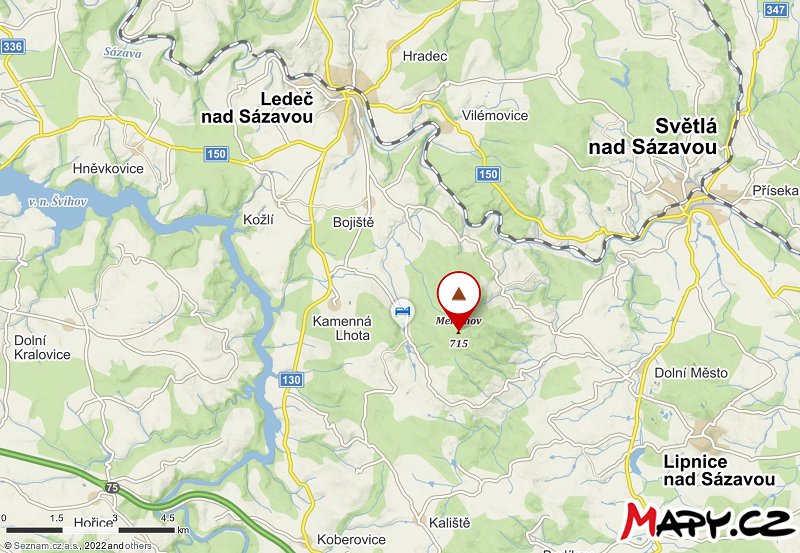
Map showing Ledeč, Melechov, and Lipnice from Mapy.cz, which is an excellent source of world-wide maps.
Melechov Hill (red pin) is halfway between Ledeč nad Sázavou and Lipnice nad Sázavou. Surprisingly, the latter town is not located on the Sázava River. The altitude of the peak is 715 m = 2,346 ft., but the hill only rises about 500 ft. above the surroundings.

Aerial View of Lipnice nad Sázavou from Wikipedia files. (Source link.)
___________________________
Beech Oil
Once we stopped at a house lower down near the village and there we were offered a plate of nice buns. My heart smiled at them and being always hungry, I reached out with a good appetite for them. But then I couldn’t look at them for they were so tough and had been fried in some sort of peculiar oil. I tried to hide my disappointment, but my father noticed this and on the way back he explained that they were buns fried in the oil of beech acorns.
Sometimes we stayed on there until evening and we heard the church bells ringing around the town, at which time everyone crossed himself. Such adventures are my dearest memories. My father always told me lots of stories and he taught me many things.
_ _ _ _ _ _ _ _ _ _ _ _ _ _ _ _ _ _ _ _
Bill’s note:

The inner nut of the American beech is prized by forest foragers, although obtaining the inner meat involves several layers of husk removal. (Source link.)
However, the American Beech Fagus grandifolia is different from the European Beech Fagus sylvatica. The oil of European beech nuts contains oxalic acid. It is mildly toxic but is somewhat removed by heating. (Source link.)
___________________________
The Spooky Forest
About two hours from Ledeč is Dolní Kralovice, connected by a nice highroad, but for walking [there was] a shorter way [directly through the woods]. Beyond Kralovice is a small estate where my father often went to do his harness work, which usually took several days. On one such occasion he went there again and explained that he would be back in the evening of the same day and I promised that I would meet him there.
That day after school I told my mother that I was going to meet my father. Outside I put on my boots and hurried so that I could walk very far. The farther I went, the happier I became. I didn’t see my father and went way into the town of Kralovice. Along the way I was imagining how nice it would be to go through the forest at night and especially to the town of Budeč where I had heard there were frightening spooks. I knew that my father was not frightened by these things and when I was with him, I wasn’t either.
But how surprised I was when I was told that my father had started home early in the afternoon. We must have passed each other without seeing each other. Without much deliberation I pulled myself together and again hurried toward home. A short distance from Kralovice the bells began ringing. I hurried on so that at least I would soon be through the woods at Budeč. I tried to make myself feel like a hero but believe me, I would rather have had that place behind me. It was already dark when I got there. My ears were stretched out so that I heard every dry twig crack under my feet. In this unhappy place, in the middle of the forest, there was a small clearing where I had a good view. But nothing happened. I don’t know what I would have done if by chance something suspicious had appeared before me and frightened me.
At home my mother said that as soon as they missed me they had decided that I had really gone to meet my father, and since it was already late in the evening and I hadn’t returned, they began to worry and went out to look for me.
The next day I couldn’t get out of bed. For several days the joints in my legs were swollen.
In spite of that, among the boys I made myself out a hero and bragged about how I walked all the way to Kralovice and through the forest at night all by myself, and was afraid of nothing.
_ _ _ _ _ _ _ _ _ _ _ _ _ _ _ _ _ _ _ _
Bill’s note:
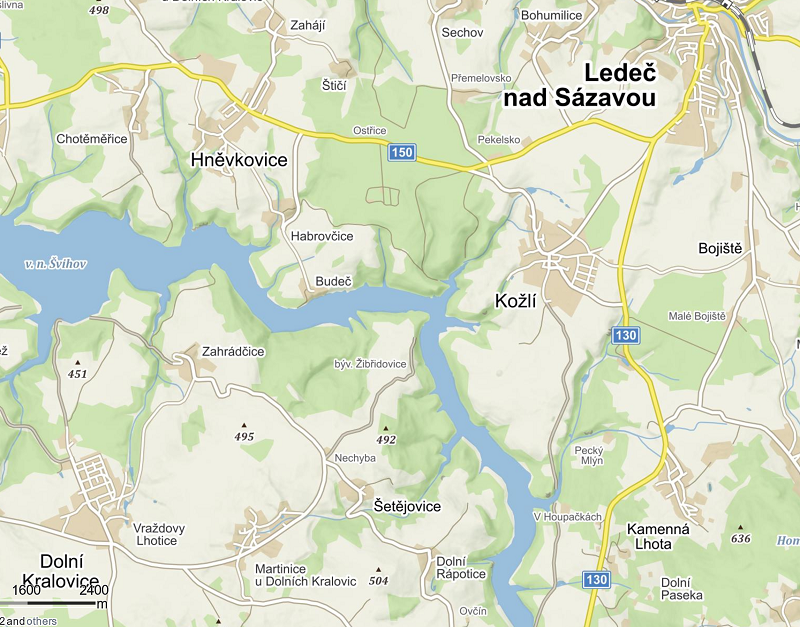
Map of Dolní Kralovice (lower left) to Ledeč nad Sázavou (upper right), more than six miles as the crow flies. A crow would fly over Budeč, and fortunately the Želivka stream had not yet been dammed and turned into a wide, ten-mile long reservoir. The present highway most likely follows the older high road, and is significantly longer than a shortcut through the forest at Budeč. (Source link.)

As the sun goes down on Beech Mountain Trail. Oops, this is in Acadia National Park, Mount Desert Island, Maine, where the Skocpols have a summer home.
But the following is a Google Street view from an area that is still forested near Budeč.
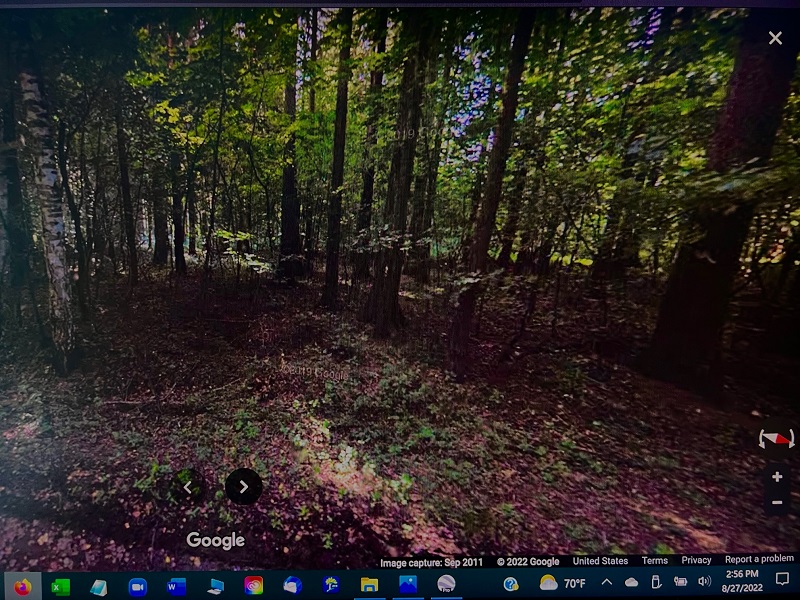
___________________________
Local Crafts
I remember when we first had oil lights. Before that we had only candles made from tallow and later made from paraffin. In poorer families they made light from pine wood or wood splinters. The shoemakers worked in front of a glass globe full of water and behind this was a candle. In almost every home there was a spinning wheel and sometimes the neighbors gathered in the spinning room, one standing next to the other, telling stories of the bewitched prince and princess; about the girl in the ashes and how her father brought her a little nut and from it a beautiful gown poured out, or about Meluzine and the Knight.
In every town there was a pot maker—porcelain ware was a luxury. I also remember how my older sister sent me on April Fool’s Day to leave a broken pot at the pot maker’s so that he could fix it. Wealthier families had pewter dishes.
There were no sewing machines, or hardly any other machines. Men’s hats could not be bought but had to be made to order as were shoes and other clothes. Pictures, especially colored ones, were very expensive. Once I traded with a schoolmate and he gave me a small picture of a Negro with red lips and white around the eyes. That was the first time I ever saw a Negro — only in a picture. For it I gave him about half a dozen of my best buttons, pure “metal” as we called these brass buttons.
_ _ _ _ _ _ _ _ _ _ _ _ _ _ _ _ _ _ _ _
Bill’s note:
The folk tales told by the spinners are familiar even today in some form, except perhaps for Melusine and the Knight. This folk tale was first written down by Jean d’Arras in the late 1300s. For some disobedience, Melusine had been cursed to have a serpent’s tail every Saturday. When she marries, she makes her husband promise never to look at her on Saturdays, when she enters seclusion. This arrangement worked well, and the kingdom prospered. However, suspicious of a possible lover, he eventually took a peek. When much later he slips up and calls her a “serpent”, she knows that he has violated his promise, and grows wings and flies off.
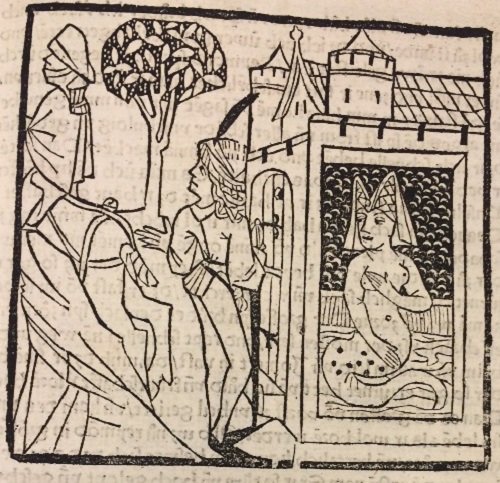
Mélusine bathing in secret: woodcut from Dis ouentürlich buch bewiset wie von einer frauwen genantt Melusina … ([Strassburg, ca 1477])
___________________________
Cards and Liquor
My mother had a great prejudice against card playing or drinking liquor. She never liked to see anyone drinking or playing cards even though we had an inn. She had a reason for this. She was born in Pavlov near a mill on a stream. Her parents were quite well-to-do for they had, together with the mill, quite a lot of farmland, and all without debts. The property was shared with my mother’s brother, who, earlier, before his father died, came into the ownership of the property. Playing cards and drinking liquor ruined his life and my mother often related as an example to us what ingratitude it resulted in and how in the end, he drank up all his property.
When finally he sat in wretched poverty in the saloon, he put his head in his hands at the table and fell asleep. The innkeeper angrily went up to him and all of a sudden pulled the chair from under him, and on falling, my uncle struck his forehead against the sharp trestle of the table and cut the skin from his head. After it healed he got a little better, but it was then too late.
Near their mill was a poor crippled tailor who had a son. As my mother told it, in the worst years, since earnings from that kind of tailoring were not large in the country, he often got work at the mill to earn a living. His son, who also had learned tailoring, went to Prague and after working there the whole summer was able to buy a farm.
_ _ _ _ _ _ _ _ _ _ _ _ _ _ _ _ _ _ _ _
Bill’s note:
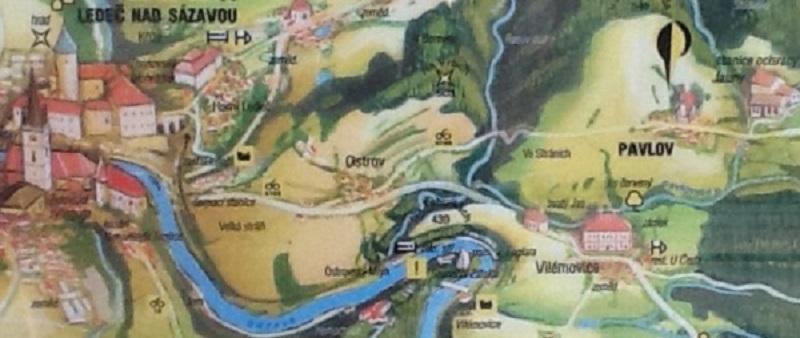
Pavlov is less than three miles east of Ledeč nad Sázavou, just before the Pavlovský potok (stream). The mill was most likely on this stream. Frank’s mother, Barbora Bradac, was the daughter of Jan Bradac and Frantiska Muller, through whom the mill was probably inherited. Her ill-fated brother was Jan Bradac, Jr.
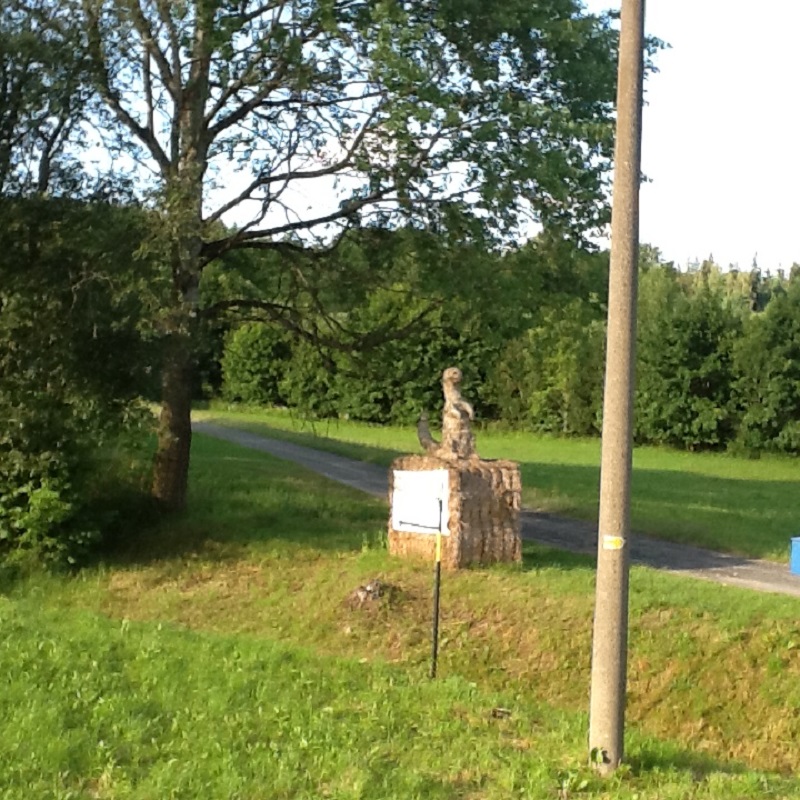
A current feature along the stream is a Wildlife Rescue Service: “Stanice Pavlov, o.p.s., Non-profit and humanitarian institution, Pavlov 54, 58401 Pavlov, Havlíčkův Brod District, Vysočina Region, Czechia.” Mapy.cz says that it has a small wildlife zoo and a specialised department that “focuses on issues of species conservation, research and protection of the river otter, endangered species of owls or the European mink. Tours of the rescue station for the public are an important part of our environmental education activities. The tours are always guided.” This picture by Bill Skocpol shows the sign marking the turnoff to it. The animal sure looks like a river otter!
Other pictures by Bill in 2015 included Frank’s mother’s birthplace, Pavlov čislo 2 (House #2)
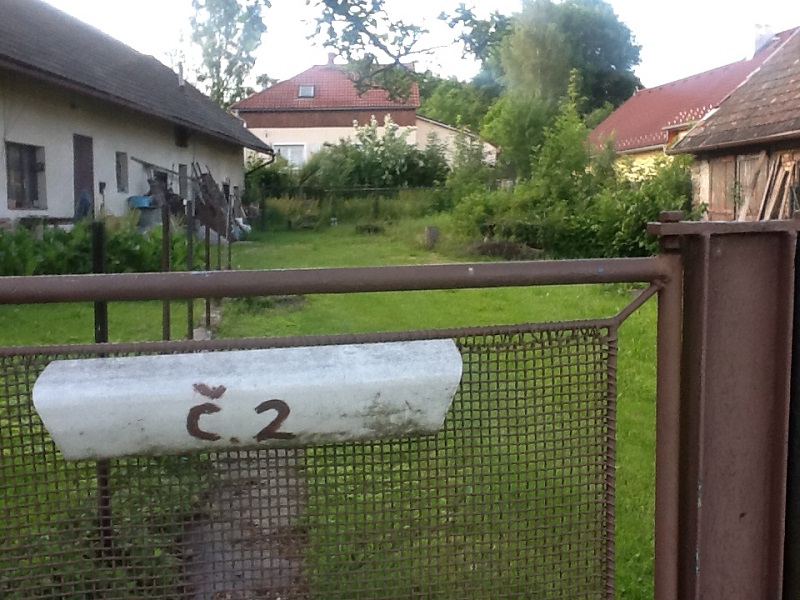
They had a sizable property indeed: House, Barn, and Rear of Barn along a side road.
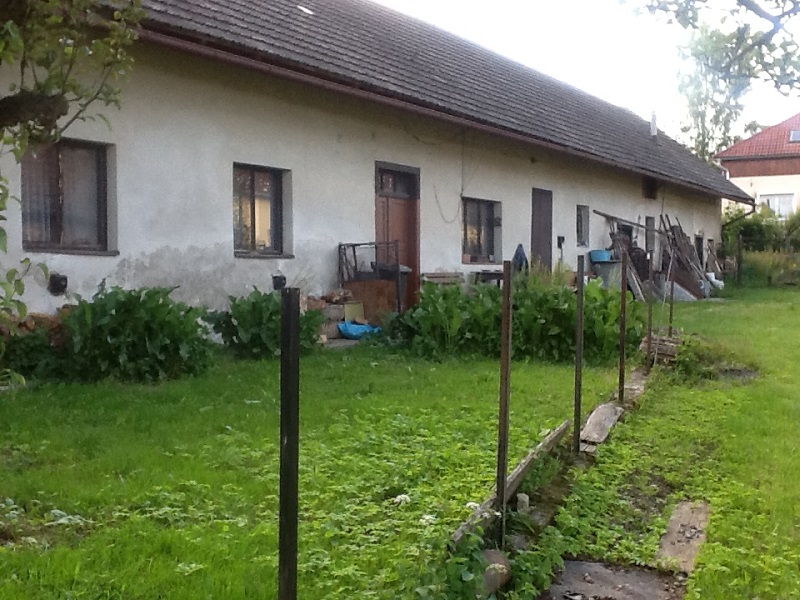
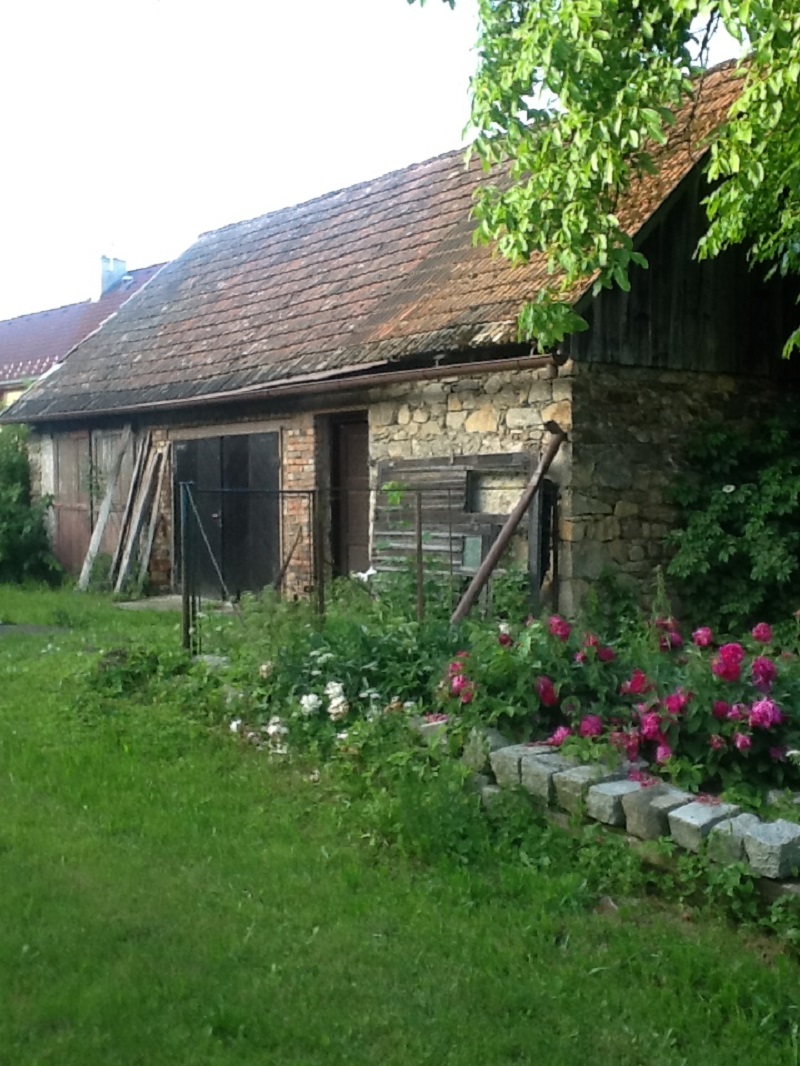
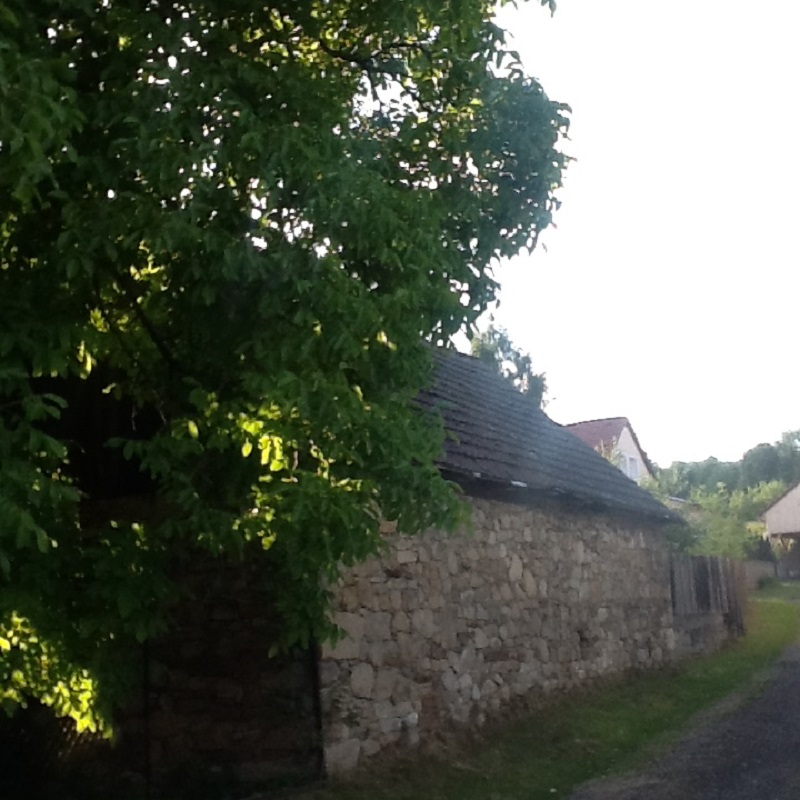
___________________________
Wise Jewish Neighbors
In my birthplace, Ledeč nad Sázavou, there are many Jewish people and among them, at that time, many who were wise and educated. I partlcularly remember one who was an older grayhaired man; it seemed to me that I was constantly listening to him. He came to our inn daily. He had a grocery store across the square and his name was Kern. He called my father Johan and told stories like parables. Once he said, “Everyone on earth complains that he has some kind of cross to bear, and everyone thinks that his is heavier than his neighbor’s. But if all these crosses hung on a pole and everyone could pick out a different one, he would still go and choose his own.”
In the town a young Jew started a sheep shearing business and soon after, he bought a horse and a buggy and began to ride to neighboring towns to the annual fairs. Once when he was going he met old Mr. Kern near the town on the high road and said to him, “I’m going to Janikov and I’m late.” And the other replied, “Just go, but let me tell you, you are going too soon.” In a short time the young Jew was bankrupt and at the first opportunity Kern told him, “You see, I told you that you went too soon. You should have walked first, and then ridden.”
_ _ _ _ _ _ _ _ _ _ _ _ _ _ _ _ _ _ _ _
Bill’s note:
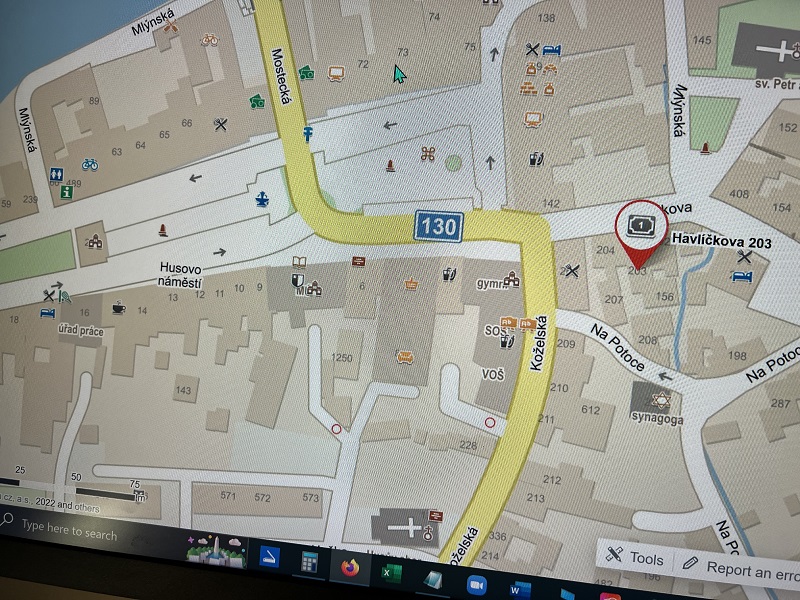
The center of old Ledeč. The Sadilek inn was #12, located near the final “i” in the label Husovo Náměstí. The red-marked house, Havlickova 203, belonged to the grandparents of Gustav Mahler (1860-1919). Gustav’s mother Marie Herrmann grew up there, but moved elsewhere when she married Bernard Mahler in 1857. In 1860 they returned to the Ledec synagogue (marked by map) to have Gustav circumcised. At age four, when thirteen-year-old Frank Sadilek lived about 500 feet away, Gustav discovered a piano in the loft of the grandparents’ home and started playing it. Thus began his musical career as a child-prodigy pianist, and later as a famous conductor and composer. He frequently visited the grandparents, as well as his mother’s sister Barbara Freischberg at Husovo Náměstí 141.
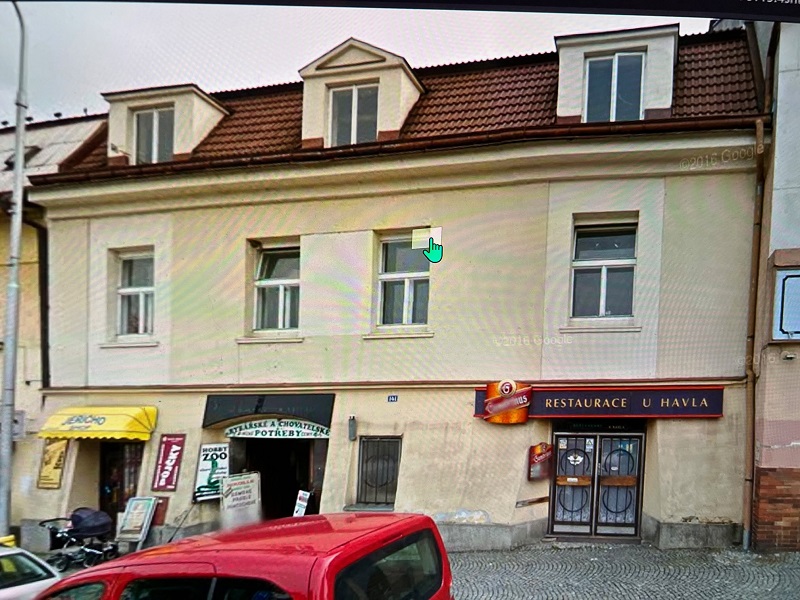
In 2015, I enjoyed visiting U Havla at this address and talking with Patrik Havel, who was a fount of information and old pictures of Husovo Náměstí. Of course the beer on tap was excellent, too.
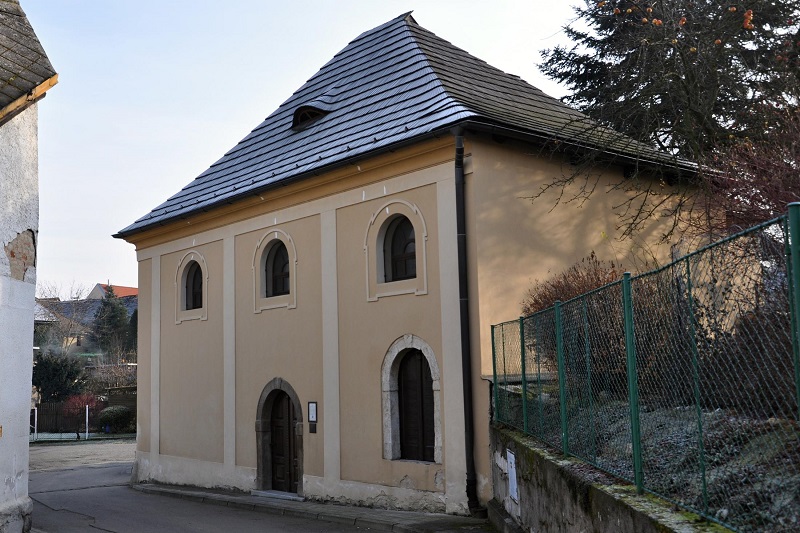
The synagogue at Ledeč from photo gallery at Mapy.cz
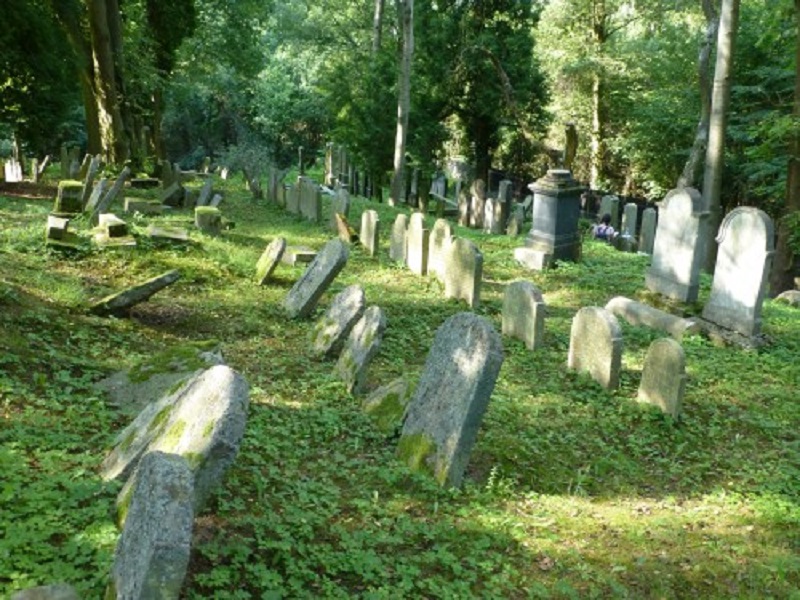
The Jewish Cemetery in Ledeč nad Sázavou, where Mahler’s grandparents are buried. (Source link.)
___________________________
Cards Instead of Church
From my early memories, I remember mischief most — how I carried out my impish plans, and also I remember the last whipping from my father for pulling carrots from a neighbor’s field. There were several of us there, but I was the one who was accused, and I carried the blame. I have never believed in the physical punishment of children for I well remember how much more I was influenced by peaceful discussions than by bodily punishment.
Like any thirteen- or fourteen-year-old boy, I had a passion for playing cards for money, even though it was only for pennies. My parents had an inn and at that time there was a lot of card playing for money and I was completely happy when I was able to watch from behind, though my father always drove me away when I was caught. I saved every penny so that I could play cards with my comrades, and best of all was playing on Sunday instead of going to church.
In a distant garden, surrounded by a wall, we found a little bower and for safety we stuck small stones into the lock of the gate so that it wouldn’t open right away if someone came to disturb us. The garden belonged to an Israelite who lived in the town and was named Miller, but because he had hair as red as saffron, and also because there were other people in the town with that name, we called him Kolčavka (little weasel). When the bells rang for the elevation of the host at the high mass, we hurried again towards the church and then home with the others.
_ _ _ _ _ _ _ _ _ _ _ _ _ _ _ _ _ _ _ _
Bill’s note:

Salonik Saffron (Image source).

Least weasel (Source link).
You can enjoy watching an active “Least Weasel” at this link.
___________________________
Caught!
One Sunday, near the best cemetery in town, we were playing Twenty-One when we heard a big noise. All of a sudden there appeared among us (I don’t know how she got there) the mother of our comrade Svoboda. “So, you degenerate boys,” she began, “this is your church?” Meanwhile, when her son began explaining, the rest of us ran away. I came home, as if nothing had happened and wanted to kiss my mother’s hand (my father wasn’t home at the time or it would have been worse) and my mother turned to me and said, “Well, we waited for your birth with great joy and now you, instead of going to church, go to Kolčakov’s garden to play cards!” My mother was not very friendly towards cards.
_ _ _ _ _ _ _ _ _ _ _ _ _ _ _ _ _ _ _ _
Bill’s note:
Barbora Sadilek was a devout Roman Catholic. Frank’s given name was not just “František” but “František Serafinsky”. This is standard reference in Czech to St Francis of Assisi. Why? Church lore asserted that a flaming Seraph appeared to Francis in the vision from which he awoke with Stigmata, marks of the wounds of Christ. This occurred in September 1224, he died in October 1226, and Pope Gregory IX made him a saint in July 1228, just two years after his death.
There is a gallery of 15 closer views of the Church of St Peter and St Paul in Ledeč. Click to view gallery.
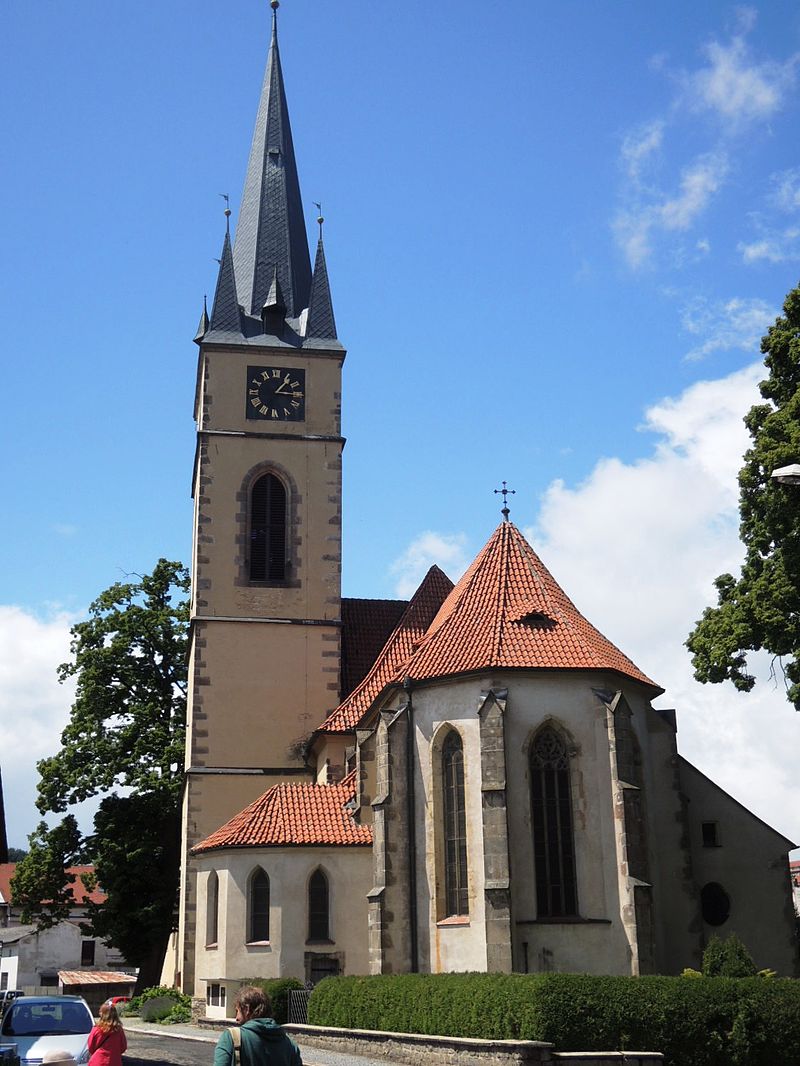
(Image source.)
The church was built in stages between around 1400 and 1535. Particularly unusual is the nave’s web-vault that has a decorative (not supporting) function only, built by Ledeč potters from ceramics in the early 16th century.
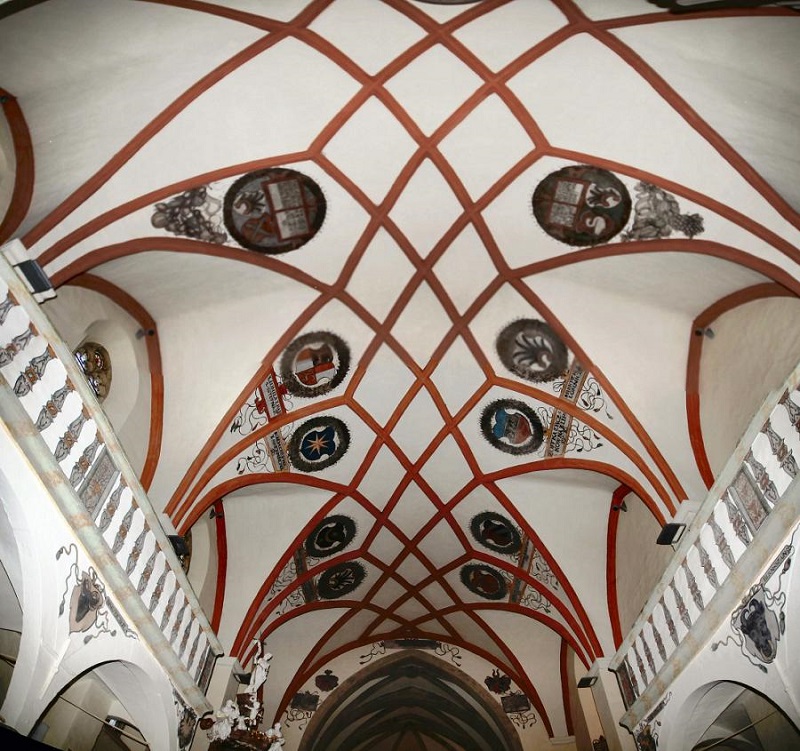
(Image source.)
___________________________
Letters from Nebraska
Sometime around the year 1865 a certain farmer from a village near Svetle used to come to our place and also often gather with his friends at the district office. I don’t know if he actually had a better education but he was clever and also knew German which was very valuable in an office. I remember his appearance so well, as if he stood before me today, a typical Czech farmer, slim and tall, no beard, a pointed chin and covered up down to his boots with an apron. At that time he was very much in debt and his greatest hope was America. If he could have got rid of his farm, he would have gone there immediately. My father was in the same situation and so they often agreed and talked only of America.
Houška, which was his name, brought news of acquaintances and relatives from letters from America and he always read them aloud and discussed :hem. My father also received mail from my uncle, his brother-in-law who was married to his sister. They had already settled in Chicago in the summer. Every conversation led to America. Once, I well remember, Houška read a letter from his friend who, I think, lived somewhere in Nebraska near the Missouri River, either in Pawnee or Richardson County. He wrote of the richness of the land; how luxuriously the grass grew, that there were plenty of rabbits where they lived and different wild animals, and he wrote of the wild turkeys, how it was possible to shoot them and that they even found honey from wild bees in the trees. Houška was so enthusiastic that he paced before the bar with not enough patience to sit down. He said, “Mr. Sadilek, we won’t go anywhere else but to Nebraska and to the end of our lives we’ll live on butter, milk and eggs.”
To round off my story about this… In the year 1882, in February, I was on a visit to Chicago and I noticed that my father was becoming weaker so I persuaded my parents to come back with me to Nebraska and the following June in the beginning of the month they came. I had a nice little house prepared for them but my father died on the 30th. Just a few hours before his death he was lying, eyes closed, and was breathing heavily. I sat by his bed and realized that his life was coming to an end, and the thought occurred to me that it was a peculiar fate that the place he so longed for was the place he came to die in. Bracing myself, to cover up my emotion, I bent down toward him with this question: “Do you remember, Father, what Houška used to say when he visited us in Ledeč?” “Yes,” he replied, not even opening hix eyes, “he said that we would live on butter, milk, and eggs in Nebraska.” And so, though my poor father lived here only thirty days, he could not tolerate any food except something bland and liquid and that was milk with eggs and butter.
_ _ _ _ _ _ _ _ _ _ _ _ _ _ _ _ _ _ _ _
Bill’s note:
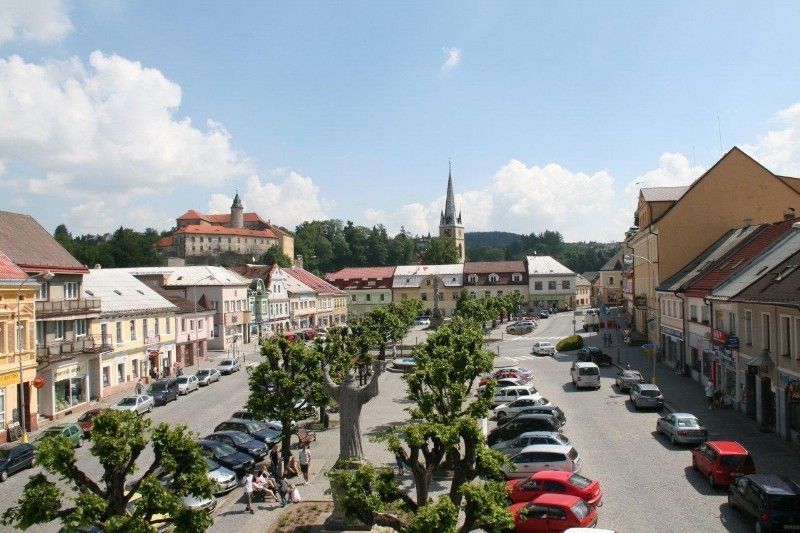
(Image source.)
___________________________
Kytka’s note: This article is the original part of Chapter Two of the book entitled Frank’s Wilber: The Early Days of the Czech Capital of Nebraska (as told by Frank J. Sadilek). It’s currently out of print, but you can contact the Wilber Czech Museum at Nebraska Czechs of Wilber for availability of the book.
Guest Post Author
William J. (Bill) Skocpol is a former Boston University Physics Professor who knew three generations of his Czech-American ancestors in Nebraska. He went through elementary school in Crete, Nebraska, and still is included as a member of that high school graduating class. He is a long time and loyal supporter of this website.
Thank you in advance for your support…
We know that you could spend hours, days, weeks and months finding some of this information yourselves – but at this website, we curate the best of what we find for you and place it easily and conveniently into one place. Please take a moment today to recognize our efforts and make a donation towards the operational costs of this site – your support keeps the site alive and keeps us searching for the best of our heritage to bring to you.
Remember, we rely solely on your donations to keep the project going.
We appreciate you more than you know!
If you have not already subscribed to get TresBohemes.com delivered to your inbox, please use the form below now so you never miss another post.




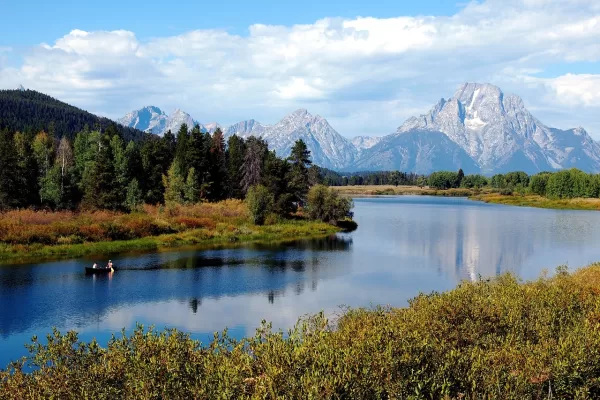
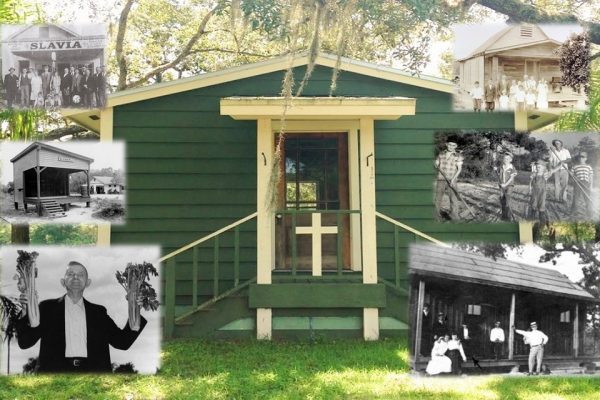
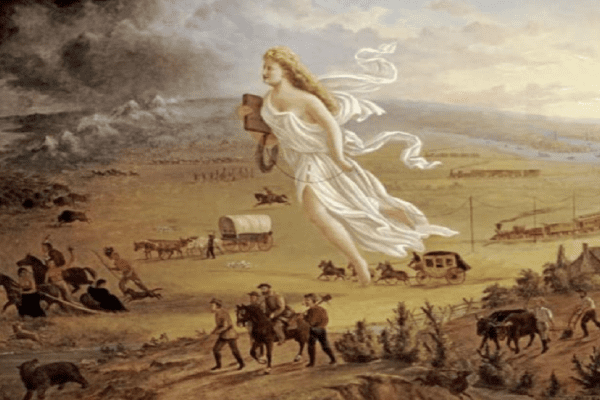















Great post today. Thank you to Bill for adding this too your site. I love your content but also enjoy the guest posts every now and again.
I enjoyed this format of past and present. Well researched and interesting reading.